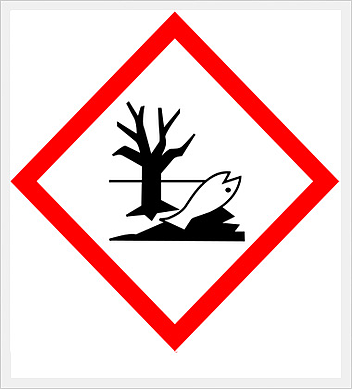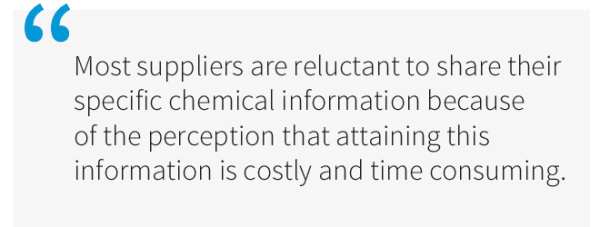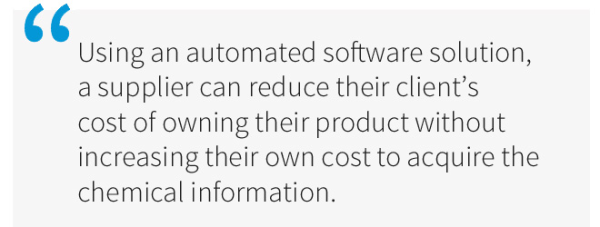Understanding the Globally Harmonized System (GHS)

The Globally Harmonized System (GHS) is an attempt to standardize the classification of labels and packaging across borders. As such, the new Globally Harmonized System guidelines for Classification and Packaging impact the classification of the hazards of chemicals as well as the communication of hazard information through SDSs, Labelling and Employee Training.
Internationally, federal regulators are starting to adopt these guidelines to improve the communication of environmental and health hazard metrics between State boarders more efficiently. For example, the Hazard Communication OSHA Standard Final Rule in the U.S. was passed May 26th, 2012, with a final implementation date for 2015. The GHS standards work by employing a “building block” concept: each country is free to choose which “building blocks” of the GHS system to adopt into their relevant sectors and match it with the GHS rules for classification and labels. Therefore, different countries can implement different versions of GHS. Unfortunately, this means that some of the less straightforward data - such as enhanced GHS environmental metrics may - not make the cut in some countries.
One beneficial addition of GHS is the SDS Section on Ecological Information. This section details aquatic and terrestrial ecotoxicity, persistence and degradability, bioaccumulative potential, mobility in soil and other adverse effects on the environment. While the addition of this section is commendable and puts more emphasis on “environmental, health and safety,” OSHA has no present requirement to include this section. As a result, most vendors are opting out of going the extra mile when it isn’t required.
The non-requirement for ecological information section on the SDS has a number of consequences that bring up whether environmental information should be required and what could be preventing EHS professionals from supplying this information. A popular argument is that MSDSs were not designed or intended as a source of information for environmental reporting and that trying to incorporate information necessary for this change places increased cost and burden on vendors and suppliers. However, in light of the GHS SDS’s inclusion of an Ecological Information section and that section being adopted in all European nations is evidence that the situation is taking small steps towards becoming a fully informative document.
This article will examine the challenges behind providing additional data, such as ecological information or even proprietary information, and why chemical suppliers should seriously consider providing this information for their own benefit and competitive advantage.

The Supplier-Vendor Vicious Cycle of SDS Information
The problem with old-fashioned MSDSs is that they’re expected to do double duty with the bare minimum information. With a single MSDS there is a tug of war between supplying the end user all of the information that they will need to safely and responsibly use the product, and protecting the supplier’s proprietary product information. This same situation has trickled down to the new GHS-style SDSs.
As a result, many suppliers end up authoring vague SDSs and defaulting to the highest possible percent values for chemical components to avoid divulging their special mixes and chemical compositions. Unfortunately this vicious cycle ends in a lose-lose situation because the end users become less loyal to these suppliers as health& safety and environmental departments end up spending extra resources performing investigative actions which increases the cost of buying from suppliers who withhold environmental information.
The Cost of Sharing Information
Why is it that environmental information always needs to be wrestled out of the hands of a supplier? Most suppliers are reluctant to share their specific chemical information for a number of reasons including the risk it might give their competitors an advantage, and the perception that attaining this information is costly and time consuming.
When a supplier is asked to provide additional environmental information to their end-users, it requires time, which in the absence of an automated information system can be significant, especially for chemical vendors with many materials and products. This creates a constant back and forth struggle between the supplier and the vendor in which one tries to get more information while the other is tries to pay for the cost in attaining and communicating it.
The problem is further increased when information sharing is between competitors, which can happen in large complicated supply chains such as the automotive and aerospace sectors. In such situations where information about the product and its manufacturing needs to be tightly held, transmitting environmental information can be very delicate and sensitive due to the communicative nature of the supplier and the client relationship in such situations.
The Flip Side: Benefits of Sharing Information
If you are a vendor of finished goods, one of your goals is most likely to reduce the costs of storing your inventory. This goal is mainly accomplished by choosing the right supplier: the supplier that offers the lowest cost. With the new GHS underway, suppliers have a unique opportunity to lower the cost of your product ownership by supplying you, the vendor, with upfront chemical information.
The GHS SDS has an optional Ecological Information section. For the most part, regulatory bodies like OSHA, are leaving this section optional. However, if vendors asked for this information to be filled out then they would instantly have access to environmental information necessary for reporting. This would also reduce the time spent gathering the necessary information.
Compacting Environmental and Safety Data
Providing environmental information on an SDS can encourage combining information. Despite regulatory bodies like OSHA dealing specifically with Health and Safety, most companies need to evaluate their incoming chemicals through and environmental reporting and performance lens as well.
Say you are receiving a shipment of toluene: you need to know its potential harmful effects to your employees. However, you’ll eventually need to know what toluene’s effects are on the environment for reporting calculation purposes and corporate social responsibility reasons… a lot of time can be saved by having all that information in one reliable document.
As a supplier, offering your clients a one-stop-shop for all of this information is a huge competitive advantage. This is because you are helping your client lower the cost of owning your product. For this situation to be mutually beneficial, the trick is to offer this advantage without increasing your own costs.
Using an automated software solution, a supplier can reduce their client’s cost of owning their product without increasing their own cost to acquire the necessary chemical information and data to supply this additional information. This is because the collection, storage, and maintenance this information is centralized into one database where a supplier can instantly update any technical or formulation changes. This drastically reduces the cost of time, which both suppliers and their clients know so well. Additionally, changes are made in a standardized format so translating formulation change is done through an automated system. In other words, the health department can extract the information they need just as easily as the environmental department is notified of a technical change that could affect reporting.
An SDS software, like the one ERA Environmental Solutions offers, can improve the transfer of information between the suppliers and their clients. This tool can enable the potential win-win situation for both sides of the supply chain. It is just a matter of understanding how the suppliers can increase their competitive advantage and lower the cost of time while helping their clients all at the same time.

The Need for a Third-Party Solution
Since two of the largest hurdles in suppliers providing environmental metrics and information to clients are cost and security. If you have an automated Environmental, Health and Safety system, then uploading a single SDS into the system would be able to extract information available for a wider range of reporting. One document, more reports. Putting this information in an SDS would allow EHS professionals to upload and centralize both their health & safety and their environmental information. Generating a consolidated pool of data promotes increased efficiency and reduces the time needed to re-contact certain suppliers and chase after them for environmental information to generate an EDS or TDS.
The important thing to remember is that these environmental reporting actions are mandated by regulators and therefore have to happen. This means that suppliers who make it easier and cheaper for clients to perform these reporting actions gain an economic advantage as it reduces the cost of owning their products.
Having an intermediary data sharing service can ensure that information is transferred more securely – which puts everyone at ease. An automated solution into which vendors can upload their data securely and that can generate valid environmental reports such as the TDS and EDS is one way to seamlessly integrate EHS management with your SDS management. Such a software platform ensures that valuable information is protected through a non-disclosure act and is viewed by the right people. This system can help mould a tighter, stronger supplier-vendor relationship and turn a lose-lose situation into an easy win-win.
This Blog was Co-Authored By:


June 5, 2014
Comments